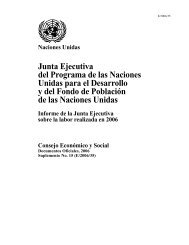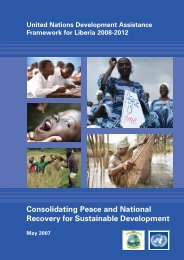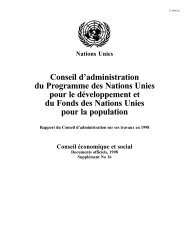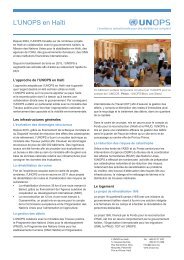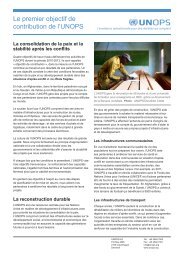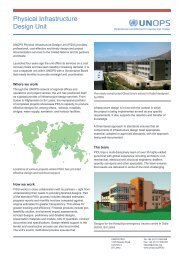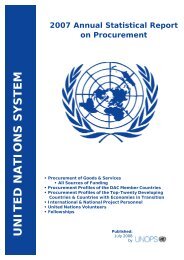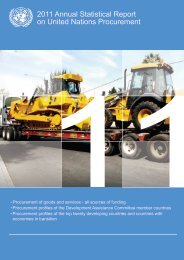India UNDAF 2008-2012 - UNOPS
India UNDAF 2008-2012 - UNOPS
India UNDAF 2008-2012 - UNOPS
Create successful ePaper yourself
Turn your PDF publications into a flip-book with our unique Google optimized e-Paper software.
<strong>India</strong> <strong>UNDAF</strong> <strong>2008</strong>-<strong>2012</strong><br />
In recognition of the need to consolidate efforts and optimize the use of resources the<br />
Government has decided to focus on a few critical flagship programmes such as Bharat<br />
Nirman, Sarva Shiksha Abhiyan (SSA), Integrated Child Development Services (ICDS),<br />
National Rural Health Mission (NRHM), National Rural Employment Guarantee Scheme<br />
(NREGS), Jawaharlal Nehru National Urban Renewal Mission (JNNURM), National<br />
AIDS Control Programme (NACP), the Total Sanitation Campaign (TSC) and Swajaldhara.<br />
Since development issues are inter-dependent and such large centrally sponsored<br />
government programmes seldom intersect this is also an opportunity to explore<br />
synergies between the various sectors that these programmes address.<br />
Current data indicates that sections of the population, disadvantaged on the basis of<br />
geography, caste or gender, continue to remain excluded from access to public services<br />
and perform poorly on the socio-economic indicators. According to the National<br />
Family Health Survey-2 (1998-99), the IMR among Scheduled Castes was 83, and<br />
among Scheduled Tribes, it was 84 – almost 30 percent higher than in the rest of<br />
society. In terms of gender disparity, worrying social trends persist: the overall sex<br />
ratio in 2001 was 933 women to 1,000 men, work participation rate in 2001 amongst<br />
women was 31.32% as opposed to 58.96% for men 4 and 39% of all AIDS cases reported<br />
relate to women 5 . While progress has been made in girls’ enrolment in schools that has<br />
increased from 49.8% (2001-01) to 57.3% (2002-03) at the primary level, girls continue<br />
to be disadvantaged as compared to boys, with 86% of boys attending school<br />
compared to only 73% of girls. Lack of female teachers in schools, declining sex ratios<br />
and violence against women further exacerbate the disparities and are in turn manifestations<br />
of gender discrimination.<br />
Geographically, the concentration of deprivation is clearly visible in the northern and<br />
eastern states of <strong>India</strong>. In 1997-98, Bihar had the lowest per capita Net State Domestic<br />
Product 6 of Rs. 1,126 as compared to Goa with Rs. 5,640 – five times higher – at the<br />
other end of the spectrum 7 . Uttar Pradesh, Bihar, Rajasthan, Orissa and Madhya<br />
Pradesh are among the worst performers on the human development index 8 and on<br />
the MDG indicators and account for 39% of the country’s population 9 . <strong>India</strong>’s success<br />
or failure in achieving the MDGs will depend largely on these disadvantaged states.<br />
Four states, Uttar Pradesh, Madhya Pradesh, Bihar and Rajasthan account for more<br />
4<br />
As per 2001 Census<br />
5<br />
Source: HIV/AIDS epidemiological Surveillance & Estimation report for the year 2005,<br />
NACO, April 2006.<br />
6<br />
At 1980-81 prices<br />
7<br />
National Human Development Report 2001<br />
8<br />
National Human Development Report 2001<br />
9<br />
Census of <strong>India</strong> 2001<br />
4




